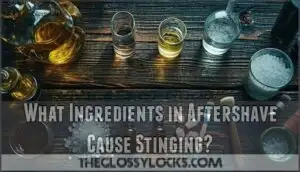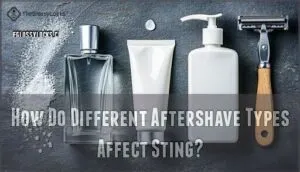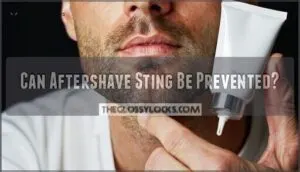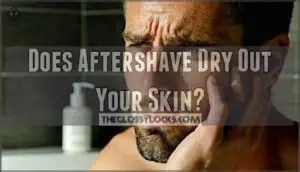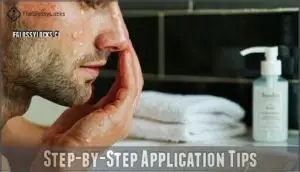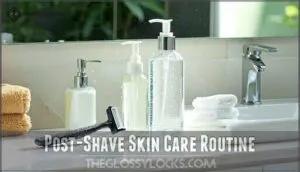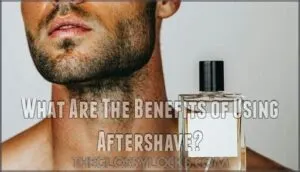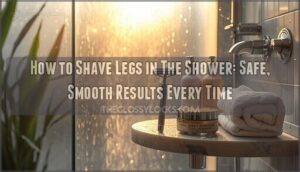This site is supported by our readers. We may earn a commission, at no cost to you, if you purchase through links.
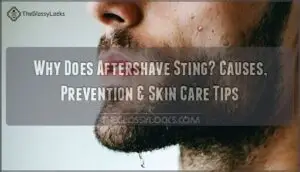 That sharp, bracing sting when aftershave hits freshly shaved skin isn’t just in your head—it’s a chemical reaction happening in real time. Your razor has just stripped away the outermost protective layer of your skin, exposing fresh cells and countless microscopic wounds.
That sharp, bracing sting when aftershave hits freshly shaved skin isn’t just in your head—it’s a chemical reaction happening in real time. Your razor has just stripped away the outermost protective layer of your skin, exposing fresh cells and countless microscopic wounds.
When alcohol-based aftershave makes contact, it evaporates rapidly, pulling moisture from these vulnerable layers while its antiseptic properties get to work disinfecting every nick and irritation. The result is that unmistakable burning sensation that makes you wince.
Understanding why this happens—and whether you need to tolerate it—comes down to what’s actually in your aftershave bottle and how your skin reacts to shaving trauma.
Table Of Contents
- Key Takeaways
- Why Does Aftershave Sting When Applied?
- What Ingredients in Aftershave Cause Stinging?
- How Do Different Aftershave Types Affect Sting?
- Can Aftershave Sting Be Prevented?
- Does Aftershave Dry Out Your Skin?
- How to Apply Aftershave Without Irritation
- What Are The Benefits of Using Aftershave?
- Frequently Asked Questions (FAQs)
- Conclusion
Key Takeaways
- Aftershave stings because alcohol and antiseptics interact with freshly shaved skin that’s been stripped of its protective outer layer, creating microscopic wounds that trigger nerve responses when disinfected.
- Alcohol-based formulas (50-90% alcohol content) provide strong antibacterial protection but strip natural oils and cause dryness, while alcohol-free balms with ingredients like aloe vera and shea butter offer gentler alternatives that maintain hydration without sacrificing antiseptic benefits.
- You can prevent most stinging by improving your technique—shave with the grain using sharp razors, rinse with cold water immediately after, pat (don’t rub) skin dry, and choose products matched to your skin type rather than defaulting to traditional splashes.
- Despite the discomfort, quality aftershave provides real benefits including bacterial protection that prevents infection in nicks and cuts, moisture barrier support through humectants like glycerin, and reduction of acne and razor bumps by up to 40-60% when formulated with ingredients like salicylic acid or witch hazel.
Why Does Aftershave Sting When Applied?
That familiar sting you feel after splashing on aftershave isn’t random—it’s your skin reacting to what you’ve just put on it. The burn happens because of how aftershave interacts with freshly shaved skin, which is more vulnerable than you might think.
Here are the three main culprits behind that stinging sensation.
The Role of Alcohol and Antiseptics
When alcohol or antiseptics hit your freshly shaved skin, they’re doing exactly what they’re designed to do—killing bacteria and tightening pores—but that protective action comes with an unmistakable sting. Here’s what’s happening beneath the surface:
- Alcohol content evaporates quickly, drawing moisture from exposed skin layers
- Antiseptic properties disinfect micro-wounds but trigger nerve responses
- Astringent effects contract tissues, creating that tight, tingling sensation
- Sanitization eliminates infection risk while temporarily irritating compromised skin
- Formulation differences between alcohol-based aftershaves and alternative ingredients determine intensity
You feel it instantly—that sharp sting is your skin’s way of saying the protection is already working.
Skin Sensitivity After Shaving
Shaving strips away more than just hair—it removes the outermost protective layer of your skin, leaving fresh cells exposed and far more reactive to anything you apply afterward. This shaving exfoliation compromises your skin barrier, making even gentle products feel harsh.
You’re basically dealing with raw, vulnerable tissue that’s prone to razor burn and skin irritation. Those with sensitive skin or product allergies experience heightened reactions, while ingrown hairs add another layer of sensitivity.
That’s why aftershave balm often feels less aggressive—it’s formulated for this compromised state, preventing aftershave irritation through gentler ingredients.
Impact of Nicks, Cuts, and Irritation
Even a tiny nick amplifies that sting tenfold—you’re practically pouring antiseptic directly into an open wound, however small. Shaving nicks and razor burn create breaches in your skin barrier, triggering inflammation that intensifies skin sensitivity.
The healing process demands moisture and protection, not harsh alcohol that delays recovery. Skin damage from cuts makes preventing aftershave burn critical—your compromised skin can’t tolerate the same products intact skin tolerates easily.
What Ingredients in Aftershave Cause Stinging?
Your aftershave’s ingredient list matters more than you might think—especially when it comes to that sharp sting you feel after shaving.
Knowing what’s actually in your aftershave helps you pick products that won’t leave your face burning after every shave.
Here’s what’s actually causing that sting.
Alcohol Content Explained
The sting you feel isn’t just in your head—it’s primarily the work of isopropyl or ethyl alcohol, which usually makes up 50% to 90% of traditional aftershave formulas. This high alcohol content delivers powerful sanitizing properties that kill bacteria, but it also strips away your skin’s natural oils, creating that sharp, burning sensation.
Here’s what alcohol does to freshly shaved skin:
- Evaporates quickly, pulling moisture from your skin’s surface and leaving it tight and dry
- Penetrates microscopic cuts, triggering an immediate stinging response as it disinfects open wounds
- Disrupts your skin’s protective barrier, making sensitive skin even more vulnerable to irritation
- Acts like a solvent, removing the natural lipids that keep your face comfortable and hydrated
If you’re prone to dryness or have sensitive skin, alcohol-based aftershaves may cause more harm than comfort. That’s why alcohol alternatives like witch hazel or aloe vera have gained popularity—they offer protection without the harsh drying effects.
Antibacterial and Astringent Agents
Beyond alcohol, your aftershave likely contains a supporting cast of antibacterial and astringent agents that add their own kick to that post-shave sting. Ingredients like witch hazel and menthol tighten pores and reduce inflammation, but they can intensify the burning on compromised skin.
While these antiseptic ingredients do kill bacteria, alcohol-based formulas tend to be harsher on your skin than their natural counterparts.
Knowing what’s in your aftershave lets you pick products that protect without punishing your face.
Natural Vs. Synthetic Ingredients
You’ll find both natural and synthetic ingredients in aftershaves, each with distinct trade-offs. Natural aftershave ingredients like essential oils offer sustainability factors and cleaner ingredient sourcing, but they come with allergenic potential—limonene and linalool can sensitize skin just as harshly as synthetic compounds.
Synthetic formulas deliver enhanced scent longevity and cost comparison advantages, though alcohol-based aftershave effects often mean more dryness. Many synthetic fragrances contain undisclosed ingredients, which can be a concern for sensitive skin.
Knowing what’s in your aftershave makes it easier to avoid irritation.
How Do Different Aftershave Types Affect Sting?
Different aftershaves hit your skin in different ways. A splash with alcohol? That’s going to sting more than a soothing balm.
Whether you reach for a lotion, splash, or balm—and what’s actually in the bottle—shapes how your face feels minutes after you rinse.
Here’s how each one changes what you feel on your face.
Aftershave Splash Vs. Balm Vs. Lotion
Aftershaves come in three main types—splash, balm, and lotion—and each one handles your freshly shaved skin differently.
Pick the wrong match, and you’ll turn a smooth finish into a burning mess.
Aftershave splash packs high alcohol content that disinfects quickly but stings more, especially on sensitive skin types.
Balms offer thick hydration with minimal alcohol, soothing irritation while locking in moisture.
Lotions fall somewhere between—lighter than balms but gentler than splashes, making them adaptable for most skin types and application preferences.
Alcohol-Based Vs. Alcohol-Free Formulas
Alcohol-based aftershave effects center on rapid disinfection but come with trade-offs—stinging sensations and alcohol drying effects that strip moisture from your skin. Alcohol-based aftershaves activate nerve receptors, causing that familiar burn without actual tissue damage.
In contrast, alcohol-free formulas rely on natural antiseptics like witch hazel and aloe vera, delivering antibacterial protection with enhanced skin barrier support. Astringency is a key factor, so balancing skin care with alcohol is important.
Studies show humectant effectiveness in alcohol-free options outperforms traditional formulas for hydration. Market preferences reflect this shift—63% of consumers now choose alcohol-free products, prioritizing comfort over that old-school sting.
Choosing The Right Aftershave for Your Skin
Your skin type isn’t just a label—it’s the deciding factor between post-shave comfort and a face that feels like it’s been slapped with fire. Choosing the right aftershave means matching ingredients to your skin’s needs:
- Oily skin tolerates alcohol-based splashes that tighten pores
- Sensitive skin demands alcohol alternatives like witch hazel or aloe vera
- Dry skin requires balm benefits with shea butter and glycerine
- Combination skin works best with lightweight lotions
- Acne-prone skin needs natural options with antibacterial protection
Knowing which ingredients suit your skin can help you avoid irritation before it ever becomes a problem.
Can Aftershave Sting Be Prevented?
Yes, you can prevent most aftershave sting with the right approach. The key lies in how you prepare your skin, how you shave, and what products you choose afterward.
Here are three straightforward ways to keep that sting at bay.
Pre-Shave and Shaving Techniques
The best defense against aftershave sting starts before the razor ever touches your face. Exfoliation benefits your skin by removing dead cells that dull blade sharpness and trap hairs.
Your shaving technique matters—use a sharp razor, follow shaving direction with the grain, and maintain proper hydration by shaving after a warm shower.
With these shaving habits and skin care steps, you can keep irritation in check and prep your skin for a more comfortable aftershave experience.
Skin Preparation and Cooling Methods
Once you’ve mastered your shaving stroke, cooling your skin immediately afterward can cut the sting in half. Cold water benefits include constricting pores and calming inflammation—key to skin irritation prevention.
Try these cooling methods:
- Rinse with cold water for 30 seconds
- Apply a cold towel compress for two minutes
- Use products with cooling ingredients like aloe vera
- Pat skin dry gently—don’t rub
- Wait before applying aftershave
This skin care routine protects against post-shave discomfort and aids overall skin health.
Selecting Gentle, Moisturizing Aftershaves
If cooling helps, picking the right product finishes the job—look for aftershaves loaded with natural moisturizers like shea butter, glycerin, or aloe vera instead of harsh alcohols that worsen the burn. Alcohol-free options work wonders for sensitive skin by boosting hydration levels without compromising antibacterial protection.
Balm benefits include longer-lasting comfort and barrier support—essential for proper skin care after shaving.
| Feature | Alcohol-Based | Balm/Alcohol-Free |
|---|---|---|
| Sting Level | High | Minimal to none |
| Hydration | Low (can dry skin) | High (locks moisture) |
| Best For | Oily skin, pore tightening | Sensitive skin, dryness |
| Key Ingredients | Isopropyl/ethyl alcohol | Shea butter, aloe, glycerin |
| Aftershave Balm Benefits | Limited moisturizing | Deep nourishment, soothing |
Does Aftershave Dry Out Your Skin?
Yes, aftershave can dry out your skin, especially if it’s packed with alcohol. The sting you feel isn’t just discomfort—it’s often a sign that moisture is being stripped away.
Here’s what’s going on, the signs your skin might be sending you, and how to keep it feeling healthy—especially if you tend to have dry or sensitive skin.
Why Alcohol Causes Dryness
When alcohol lands on freshly shaved skin, it strips away natural oils that normally keep your skin barrier intact and hydrated. This lipid removal disrupts your skin’s protective layer, allowing moisture to evaporate quickly.
Alcohol-based aftershaves accelerate dehydration effects, leaving skin tight and flaky. Over time, repeated use of alcohol-based aftershaves can compromise your skin’s ability to retain water, worsening skin dryness and weakening its natural defenses.
Signs of Over-Drying and Irritation
Over-drying from aftershave reveals itself through specific warning signs you shouldn’t ignore. You might notice dryness symptoms like tight, papery skin within minutes, or visible flakiness scaling across your face.
Redness onset and inflammation often appear alongside itching sensations and a rough texture. Studies show up to 82% of users experience skin dryness with alcohol-heavy products, while 36% develop visible skin rash or dermatitis.
Noticeable changes in your skin’s texture are clear signs that your skin needs attention and recovery.
Solutions for Sensitive or Dry Skin
Switching to gentler formulations transforms your post-shave experience without sacrificing protection. Look for alcohol-free balms with hydrating ingredients that support skin hydration without the sting.
Key solutions for dry skin and sensitive skin include:
- Alcohol alternatives like witch hazel or aloe vera
- Natural oils such as jojoba or coconut for moisturizing
- Gentle exfoliation before shaving to prevent irritation
- Patch testing new products on your wrist first
- Natural remedies with shea butter for deep nourishment
They help shield your skin from bacteria while keeping its moisture barrier intact.
How to Apply Aftershave Without Irritation
The key to avoiding irritation isn’t just what you apply—it’s how you apply it.
Your technique, timing, and follow-up care all play a role in keeping your skin calm and comfortable.
Here’s how you can turn aftershave into a soothing step that works for your skin—not against it.
Step-by-Step Application Tips
Applying aftershave correctly doesn’t require a medical degree—just a few simple steps that work with your skin, not against it. Start by rinsing your face with cold water to close pores, then pat—not rub—dry. Pour a dime-sized amount into your palm, warm it briefly, then press and pat the aftershave balm onto shaved areas using gentle rubbing motions in your shaving direction.
| Step | Action |
|---|---|
| 1. Prep | Rinse with cold water, pat dry |
| 2. Apply | Use dime-sized amount, warm in palms |
| 3. Distribute | Pat gently following shaving direction |
This post-shave care approach aids in preventing aftershave irritation while maintaining your shaving routine’s effectiveness. Product layering—like applying shaving cream beforehand—sets you up for success, and frequency of use matters: daily application keeps skin conditioned.
Areas to Avoid and Best Practices
Not every inch of freshly shaved skin needs aftershave—and some spots will punish you for trying. Skip sensitive areas like around your eyes, nostrils, and any open cuts where alcohol-based aftershave effects hit hardest.
Stick to shaved zones only, using a minimal application amount—over-saturating won’t boost skin hydration and mixing with other products risks irritation.
Following your shaving direction during application prevents causes of aftershave sting while supporting post-shave care.
Post-Shave Skin Care Routine
Your skin doesn’t stop needing attention the moment aftershave soaks in—what happens in the hours after you shave determines whether you’ll wake up smooth or inflamed. Layer an aftershave balm if dryness persists, then follow with hydration importance through a lightweight moisturizer containing natural remedies like aloe or chamomile.
Your night routine should include gentle exfoliation twice weekly, and don’t skip sun protection during daytime—postshave skin care protects vulnerable skin while aftershave ingredients and effects continue working overnight within your complete shaving routine.
What Are The Benefits of Using Aftershave?
Despite the sting, aftershave isn’t just about tradition—it actually benefits your skin in several practical ways. From fighting bacteria to keeping your face hydrated, the right product can turn post-shave irritation into genuine skin protection.
Here’s what aftershave actually does for your skin.
Antibacterial Protection and Healing
Aftershave doesn’t just sting—it actively fights the microscopic invaders that could turn a simple nick into an inflamed, infected mess. Those antibacterial properties in alcohol-based or natural antiseptics like witch hazel create a hostile environment for bacteria, preventing infection before it starts. Here’s what that protection delivers:
- Preventing Infection – Antiseptics kill bacteria on contact, safeguarding vulnerable, freshly-shaved skin from bacterial infection.
- Promoting Healing – Reduced inflammation means your skin repairs faster, with less redness and discomfort.
- Natural Antiseptics – Alcohol alternatives like tea tree oil offer antibacterial protection without the harsh burn, supporting your skin barrier while still defending against pathogens.
Moisturizing and Barrier Support
Beyond fighting bacteria, quality aftershaves act like a protective shield, locking in moisture and fortifying your skin’s natural defenses right when they’re most compromised. Ingredients like glycerine and shea butter work as humectants, pulling hydration into freshly shaved skin while reinforcing the moisture barrier. Balms with natural oils provide deeper nourishment than splashes, ensuring ingredient compatibility with your skin’s needs for best post-shave care and skin protection.
| Ingredient Type | Moisturizing Action | Best For |
|---|---|---|
| Glycerine | Attracts water to skin surface | All skin types |
| Shea Butter | Deep hydration, barrier repair | Dry, sensitive skin |
| Natural Oils (Jojoba, Coconut) | Locks moisture, mimics sebum | Normal to dry skin |
| Aloe Vera | Soothes while hydrating | Irritated, inflamed skin |
Reducing Acne and Post-Shave Bumps
The right aftershave does more than soothe—it confronts acne and razor bumps head-on. Tea tree oil at 3–5% concentration fights Cutibacterium acnes, reducing breakouts, while salicylic acid and witch hazel prevent folliculitis and ingrown hairs.
Non-comedogenic formulas reduce new acne lesions by up to 38%, making ingredient impact essential for postshave care. Patch-testing and choosing antibacterial aftershaves optimized for your skin type can drop bump recurrence rates by 40–60%.
Frequently Asked Questions (FAQs)
Can aftershave expire or lose effectiveness over time?
Yes, aftershave products do expire and lose effectiveness. Over time, alcohol content evaporates, antibacterial properties weaken, and aftershave ingredients degrade.
Scent alteration, bacterial growth in opened bottles, and compromised packaging integrity signal it’s time to replace your product.
Should women use aftershave on their legs?
Women can definitely use aftershave on their legs after shaving. It helps prevent razor burn, inflammation, and ingrown hair while addressing leg skin sensitivity.
However, many prefer gentler balms or lotions over traditional aftershave splashes, depending on scent preferences and how their skin reacts.
Is aftershave safe for sensitive facial areas?
It’s ironic—the very product designed to soothe your skin can be its biggest irritant.
Aftershave is generally safe for sensitive facial areas, but you’ll need to choose alcohol-free balms or lotions that match your skin type and avoid harsh ingredients that trigger allergic reactions.
How long should aftershave sting normally last?
Most people feel the sting for just 30 seconds to two minutes after applying alcohol-based aftershaves.
If burning lasts longer than five minutes, your skin sensitivity levels may be higher, or underlying skin conditions could be present. Individual pain tolerance and product ingredient effects also play a role.
Can aftershave replace moisturizer in skincare routines?
Think of aftershave as a pinch hitter, not a full-time player. While aftershave balm offers moisturizing benefits through humectants, it can’t fully replace a dedicated moisturizer for most skin types.
Hydration levels and long-term effects depend on ingredient overlap and your specific skin needs.
Conclusion
Think of your skin as a freshly plastered wall—smooth on the surface but vulnerable beneath. When aftershave stings, it’s your body’s alarm system telling you that alcohol and antiseptics are working overtime on compromised tissue.
The good news? Understanding why aftershave application stings gives you control over the experience. Whether you choose alcohol-free balms, improve your shaving technique, or simply prep your skin better, you’re no longer at the mercy of that sharp burn.
Take charge of post-shave sting by understanding its cause and choosing products and habits that keep your skin comfortable
Your face has been through enough—now you know how to treat it right.
- https://fineaccoutrements.com/news/the-truth-about-alcoholbased-aftershave/
- https://www.national-toxic-encephalopathy-foundation.org/wp-content/uploads/2012/01/annie1.pdf
- https://www.frontiersin.org/journals/medicine/articles/10.3389/fmed.2019.00098/full
- https://www.menshealth.com/uk/style/grooming/a746246/q-are-aftershaves-really-bad-for-the-skin-291834/
- https://pubmed.ncbi.nlm.nih.gov/19326669/

